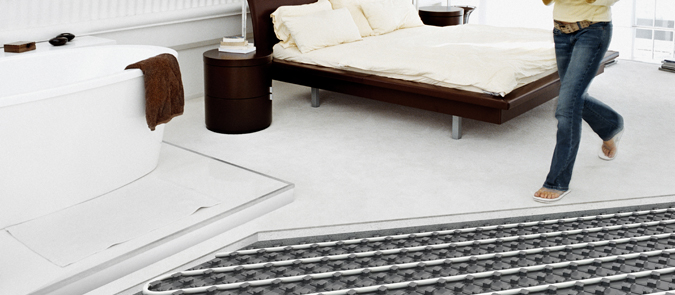Anyone who has ever experienced radiant floor heating agrees that it is the most comfortable and energy-efficient method of heating a home. So why aren’t more people installing it? Maybe it’s because they don’t know the facts. Below are some of the most common questions answered about radiant floor heating.
How does radiant floor heating work?
In a radiant floor heating system, warm water flows through flexible plastic tubing called PEX that is located underneath the floor or within the concrete slab. The PEX tubing carries the warm water into specific rooms or “zones” to effectively heat people and objects in every corner of the room. In addition to the PEX tubing, the other main components in a radiant heating system include a heat source, pumps, manifolds and controls. The heat source in a hydronic radiant floor heating system is typically a boiler or a hot-water heater. However, other heat sources can be used, including highly energy-efficient sources such as geothermal and solar.
Is radiant floor heating energy-efficient?
Yes. Because water has a capacity to transport energy 3,500 times greater than air, a hydronic radiant floor heating system can heat a home using less energy than a traditional forced-air heating system. This amounts to greater comfort at a lower thermostat setting, which provides lower energy bills. In fact, more people are comfortable with radiant floor heating at a lower thermostat setting than with forced-air heating at a higher thermostat setting. Additionally, a radiant heating system works in zones, allowing different areas of a home to heat at different temperatures. This allows typically chilly rooms, such as bathrooms, basements and entryways, to receive more heat when needed. At the same time, rooms with less traffic, such as a den or formal dining room, can be set to a lower thermostat setting, making the system even more energy-efficient. And radiant floor heating systems pair really well with highly energy-efficient solar and geothermal heat sources, making the system even more efficient.
Can the floor get too hot?
No. A properly designed radiant floor heating system will deliver comfortable, energy-efficient warmth that is a pleasure to walk, sit or lay on. If additional heat is needed to satisfy the heat load of a room or structure, it is possible to add radiant walls or ceilings to supplement the heating requirements.
Is a radiant floor heating system noisy?
The circulator pump that is used to slowly move the water through the tubing is almost inaudible, so the system functions very quietly. With a radiant floor heating system, you won’t hear the loud boom of a furnace turning on or blowers or fans running constantly.
Do you have to break up an existing concrete slab to install radiant floor heating?
Absolutely not! There are two systems that work ideally on top of a concrete slab or plywood subfloor. A radiant panel system called Quik Trak® features a low, ½” profile that makes it easy to install a radiant floor heating system in an existing structure without having to alter mouldings, baseboards or doors. And Fast Trak™ knobbed mats make it easy to install radiant by just laying the panels and snapping the tubing where ever you want it to go. It offers the fastest, easiest way to install radiant floor heating.
Can I put radiant floor heating in just one room?
Absolutely! Because radiant floor heating systems are installed in “zones”, you can choose to add a zone in any area of your home. In fact, many people choose to install radiant floor heating in their master bathroom to take the chill off floor tiles or the basement to add cozy comfort during the winter months.
Where else can radiant floor heating work?
The radiant heating concept can also be used outdoors for snow and ice melting systems to keep driveways and walkways safe and free from snow and ice. And, radiant heating works in other areas, too. Think about using radiant heat to warm the surfaces in a tub surround or shower. You can even create fogless mirrors. And for the ultimate comfort, you can add radiant to your towel bars. Just think about the inviting warmth of a cozy towel straight out of the dryer. That’s the same feeling you will get with a heated towel bar.
If I have radiant floor heating installed, can I still have air conditioning?
Yes. In fact, separate heating and cooling systems really make the most sense. Radiant floor heating keeps the heat near the floor where it does the most good; and air conditioning ductwork is placed only where it is needed to cool your home. The result is optimal comfort and efficiency all year long.
Will I need a supplemental ventilation system?
Yes, ventilation is necessary to address the latent load and bring in the required fresh air. However, the ducts can be smaller which saves structural height.
If I’m not ready to make a complete system investment right now, can I choose to add the PEX tubing during construction and hook up the system later?
Yes, you can have the PEX tubing installed in the concrete slab during construction and then hook up the system at a later time. Adding the PEX tubing prior to the concrete pour adds relatively little to the cost of a poured floor, but can add a great deal to the value of your home later.
Guest Blog Post by: Uponor

















